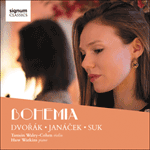
Welcome to Hyperion Records, a British classical label devoted to presenting high-quality recordings of music of all styles and from all periods from the twelfth century to the twenty-first.
Hyperion offers both CDs, and downloads in a number of formats. The site is also available in several languages.
Please use the dropdown buttons to set your preferred options, or use the checkbox to accept the defaults.

| Tamsin Waley-Cohen (violin), Huw Watkins (piano)» More |
Doubtless, Joachim’s positive response to the work was in part conditioned by certain clear affinities with the music of his friend Brahms. While Dvořák does not surrender his musical personality to the influence of his great German contemporary, there are times when he seems to be paying homage, most particularly in the manner in which the first movement ‘feels its way’ into the argument, and in the falling phrases at the start of the attractive Poco sostenuto. Apart from these lyrical aspects, a certain Brahmsian athleticism is apparent in the development of ideas.
But much else, in what is one of the composer’s gentlest works, is wholly Dvořákian, notably the cut of the second main melody of the first movement and the ‘Slavonic’ character of the finale—unsurprising, perhaps, since the first set of Slavonic Dances had been written only two years before. These elements are, on the whole, projected with far less virtuosity than in the Violin Concerto and the heaven-storming Mazurek composed the year before. Indeed, the prevalent mood in the sonata is one of lyrical expansion carried through with Dvořák’s customary generosity.
from notes by Jan Smaczny © 1998
Il ne fait aucun doute que cet accueil positif de Joachim fut en partie conditionné par des affinités certaines avec la musique de son ami Brahms. Bien que Dvořák n’abdique pas sa personnalité musicale sous l’influence de son grand contemporain allemand, il est des fois où il semble lui rendre hommage, surtout dans la manière dont le premier mouvement «avance à tâtons» vers l’argument, et dans les phrases descendantes au début de l’attrayant Poco sostenuto. Hors ces aspects lyriques, un certain athlétisme brahmsien apparaît dans le développement des idées.
Mais beaucoup d’éléments de cette œuvre, l’une des plus douces du compositeur, sont entièrement dvořákiens, notamment la coupure de la seconde mélodie principale du premier mouvement et le caractère «slave» du finale—trait peut-être sans surprise, le premier corpus de Danses slaves ne remontant alors qu’à deux ans. Dans l’ensemble, ces éléments sont projetés avec bien moins de virtuosité que dans le Concerto pour violon et le tempétueux Mazurek, datant de l’année précédente. En fait, excepté dans la sonate, où la minimisation règne, l’humeur dominante est à l’expansion lyrique, véhiculée par la générosité habituelle de Dvořák.
extrait des notes rédigées par Jan Smaczny © 1995
Français: Hypérion
Die positive Reaktion Joachims auf dieses Werk war zweifelsohne durch eine gewisse, eindeutige Affinität zur Musik seines Freundes Brahms bedingt. Dvořák gibt seine musikalische Eigenart nicht dem Einfluß seines großen deutschen Zeitgenossen hin, gelegentlich scheint er ihm zu huldigen, insbesondere in der Art, wie sich der erste Satz „seinen Weg in die Auseinandersetzung bahnt“ oder etwa mit den fallenden Phrasen zu Beginn des reizvollen Poco sostenuto. Neben diesen lyrischen Aspekten ist auch eine gewisse Dynamik in der Art Brahms’ gegenwärtig.
In einem seiner sanftesten Werke aber, den Slawischen Tänzen, ist vieles durch und durch in der Tradition Dvořáks, insbesondere der Zuschnitt der zweiten Hauptmelodie des ersten Satzes sowie der „slawische“ Charakter des Finales—das kommt vielleicht nicht überraschend, da der erste Abschnitt bereits zwei Jahre zuvor entstand. Diese Elemente kommen insgesamt mit weniger Virtuosität zum Ausdruck als im Violinkonzert und dem himmelsstürmenden Mazurka, welche beide im Jahr zuvor komponiert wurden. Wenn man einmal von der in der Sonate vorherrschenden Untertreibung absieht, so verkörpert doch die vorhandene Stimmung eine schwärmerische Entwicklung, die von Dvořáks bekannter Großzügigkeit getragen wird.
aus dem Begleittext von Jan Smaczny © 1998
Deutsch: Michael Stoffl
 Dvořák, Janáček & Suk: Bohemia - Violin Sonatas Dvořák, Janáček & Suk: Bohemia - Violin SonatasThe music of Dvořák, Suk and Janáček provides the musical backdrop to an album of bittersweet nostalgia for a time and a place now changed for ever.» More |

